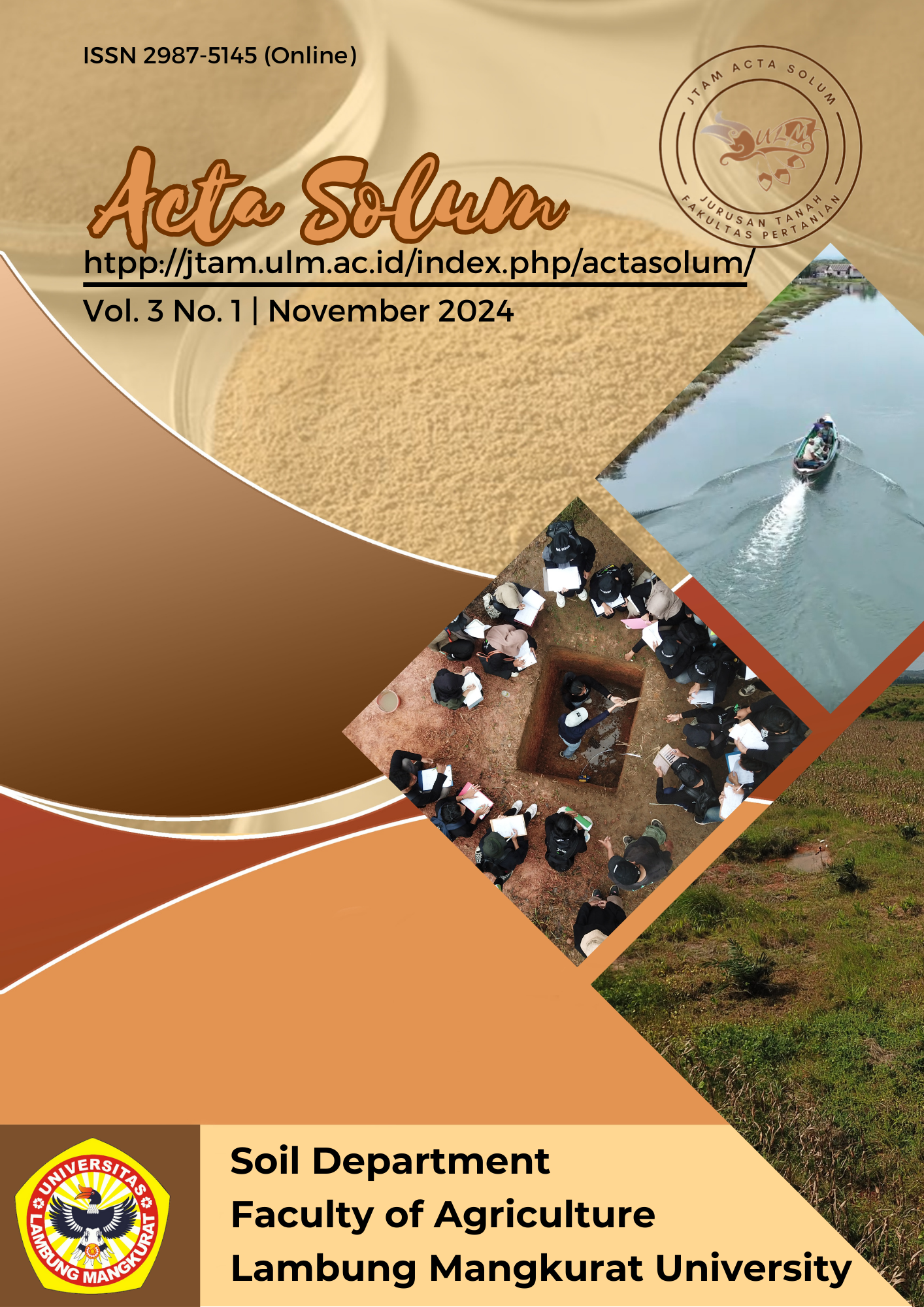Peranan Eco-Enzyme terhadap Perubahan Hara N Tanah dan Pertumbuhan Awal Padi pada Tanah Sawah Tadah Hujan
Abstract
Acid mineral soils in Indonesia mostly develop in wet tropical climates supported by high temperatures, so the weathering process runs faster than in dry climate areas. High rainfall causes intensive leaching, so basic cations are lost from the soil layer, and the soil has low base saturation. Some acid mineral soils in Indonesia are farmed under rainfed systems. This soil has a low nutrient availability status compared to irrigated rice fields, due to the lack of water availability, and is still dependent on rainfall. Eco-Enzyme (EE) contains several nutrients and microbes from fermentation that can increase soil fertility. This research aims to determine the effect of EE N nutrient availability and early rice growth in rainfed paddy fields. This study uses a Completely Randomized Design single factor, namely the total bacterial population in EE consisting of 5 treatments, namely K0= control; K1= 8,1 x 106 cells mL-1 in EE; K2= 1,2 x 107 cells mL-1 in EE; K3= 1,6 x 107 cells mL-1 in EE; and K4= 2 x 107 cells mL-1 in EE. Each treatment was repeated 4 times so that there were 20 experimental units. The results of the study show that the provision of the total bacterial population in EE 1,2 x 107 cells mL-1 can increase the pH to 5,38, N-NH4+ to 154,60 mg kg-1, and N-NO3- to 8,26 mg kg-1. Giving total bacteria in EE 1,6 x 107 cells mL-1 can increase the viability of non-symbiotic N2 fixing microbes.
References
Adeleke, R., Nwangburuka, N., C., Oboirien, B. 2017. Origins, roles and fate of organic acids in soils: A review. South African Journal of Botany 108, 393-406. https://doi.org/10.1016/j.sajb.2016.09.002
Arista, D., Suryono, Sudadi. 2015. Efek dari kombinasi pupuk N, P dan K terhadap pertumbuhan dan hasil kacang tanah pada lahan kering Alfisol. Agrosains 17(2), 49-52.
Atmojo, S.W. 2003. Peranan Bahan Organik Terhadap Kesuburan Tanah dan Upaya Pengelolaannya. Sebelas Maret University Press, Surakarta.
Bachruddin, Z. 2014. Teknologi Fermentasi pada Industri Peternakan. Gadjah Mada University Press, Yogyakarta.
Giordano, M., Petropoulos, S.A., Rouphael, Y. 2021. The fate of nitrogen from soil to plants: Influence of agricultural practices in modern agriculture. Agriculture 11(10), 944. https://doi.org/10.3390/agriculture11100944
Hartono, H., Jumadi, O. 2014. Seleksi dan karakterisasi bakteri penambat nitrogen non simbiotik pengekskresi amonium pada tanah pertanaman jagung (Zea mays L.) dan padi (Oryza sativa L.) asal Kabupaten Barru, Sulawesi Selatan, Indonesia. Jurnal Sainsmat 3(2), 143–153.
Ishak, L. 2022. Biologi Tanah. Syiah Kuala University Press, Aceh
Jadon, P., Selladurai, R., Yadav, S.S., Coumar, M.V., Singh, A.K., Bhadouriya, J., Kundu, S. 2018. Volatilization and leaching losses of nitrogen from different coated urea fertilizers. Journal of Soil Science and Plant Nutrition 18(4), 1036-1047. http://dx.doi.org/10.4067/S0718-95162018005002903
Jansson, S.L., Persson, J. 1982. Mineralization and immobilization of soil nitrogen. Nitrogen in Agricultural Soils 22, 229–252.
Kaya, E., Silahoy C., Risambessy, Y. 2017. Pengaruh pemberian pupuk organik cair dan mikroorganisme terhadap keasaman dan P-tersedia pada tanah Ultisol. Jurnal Mikologi Indonesia 1(2), 91–99. http://doi.org/10.46638/jmi.v1i2.23
Khammas, K.M., Kamil, F.A., Hasan, M.A. 2019. Nitrogen fixation and ammonium excretion by free-living heterotrophic bacteria isolated from Iraqi soils. International Journal of Biosciences 14(2), 366-375.
Munawar, A. 2011. Kesuburan Tanah dan Nutrisi Tanaman. IPB Press, Bogor.
Novianto. 2022. Response of liquid organic fertilizer eco enzyme (EE) on growth and production of shallot (Allium ascalonicum L.). JUATIKA 4(1), 147-154. https://doi.org/10.36378/juatika.v4i1.1782
Razie, F. 2003. Karakteristik Azotobacter spp. dan Azospirillum spp. dari rizosfer padi sawah di daerah dataran banjir Kalimantan Selatan dan pengaruhnya terhadap pertumbuhan awal tanaman padi. Tesis, IPB University, Bogor.
Siregar, B.L., Siallagan, R.S., Butar, S.B., Mahmudi, B., Pujiastuti, E.S. 2024. The nutrient content of eco-enzymes from mixture of various fruit peels. Agro Bali: Agrocultural Journal 7(2), 475-487. https://doi.org/10.37637/ab.v7i2.1646
Soleha, N.,Priatmadi, B.J., Mariana, Z.T. 2023. Perubahan pH, Fe-larut, dan P-tersedia di tanah sulfat masam aktual (sulfaquept) yang diberi pupuk kandang sapi dan genangan air. Acta Solum 1(2), 53-60. https://doi.org/10.20527/actasolum.v1i2.1838
Srihardyastutie, A., Rosmawati, A. 2023. Keajaiban Eco-Enzyme, dari Sampah Menjadi Berkah. PT Nas Media Pustaka, Makassar.
Tim PMEE Eco-Enzyme Nusantara. 2021. Alam, Diriku, & Eco-Enzyme, Pendalaman Materi Eco-Enzyme (Kumpulan Materi Pelatihan Kader Eco-Enzyme Nusantara). Eco-Enzyme Nusantara, Jakarta.
Zhang, S., Zhu, Q., de Vries, W., Ros, G.H., Chen, X., Muneer, M.A., Zhang, F., Wu, L. 2023. Effects of soil amendments on soil acidity and crop yields in acidic soils: A world-wide meta-analysis. Journal of Environmental Management 345, 118531. https://doi.org/10.1016/j.jenvman.2023.118531
Zhang, S., Xia, X., Yu, L., Zhang, Z., Wang, J., Wang, A., Wang, G. 2020. Both microbial abundance and community composition mattered for N2 production rates of the overlying water in one high-elevation river. Environmental Research 189, 109933. https://doi.org/10.1016/j.envres.2020.109933
Zulfarina, Z., Rusmana, I., Mubarik, N.R., Santosa, D.A. 2017. The Abundance of nitrogen fixing, nitrifying, denitrifying and ammonifying bacteria in the soil of tropical rainforests and oil palm plantations in Jambi. Makara Journal of Science 21(4), 187-194. https://doi.org/10.7454/mss.v21i4.8841
Copyright (c) 2024 Sakti Agrianto Suwandi, Fakhrur Razie, Afiah Hayati

This work is licensed under a Creative Commons Attribution-ShareAlike 4.0 International License.

















